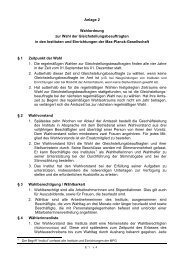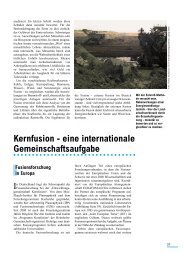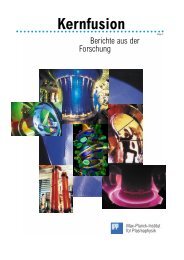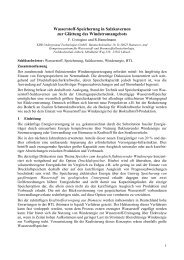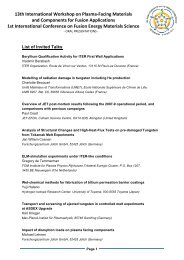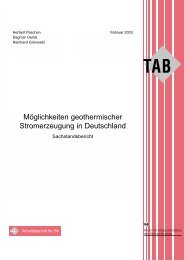IPP Annual Report 2007 - Max-Planck-Institut für Plasmaphysik ...
IPP Annual Report 2007 - Max-Planck-Institut für Plasmaphysik ...
IPP Annual Report 2007 - Max-Planck-Institut für Plasmaphysik ...
Create successful ePaper yourself
Turn your PDF publications into a flip-book with our unique Google optimized e-Paper software.
Generally, ITG turbulence is more difficult computationally<br />
because it generates large scale “zonal” flows (“zonal”<br />
refers to the flux surface average component). These flows<br />
represent the perturbed equilibrium and are involved in geodesic<br />
acoustic oscillation “modes” (GAMs). They serve to<br />
moderate the turbulence and represent a long-term background<br />
phenomenon to which the turbulence is coupled.<br />
Hence, runs must be longer and noise and saturation issues<br />
increase the difficulty. In <strong>2007</strong> the massively parallel scaling<br />
properties of the code were improved and it now runs reliably<br />
on at least 10,000 processors. A novel diagnostic to<br />
quantify the noise issues was developed; recent cases are<br />
run to saturation with the noise in the range of 5 percent.<br />
Kinetic electrons have been included. A run on 10 k processors<br />
on the Edinburgh Hector platform found well behaved<br />
long term saturation and converged scale separation<br />
(between turbulence and profile relaxation). In 2008 the<br />
Alfvén dynamics will be tested and full scale ITER cases<br />
will be run.<br />
Global electromagnetic computations of ITG/Alfvén turbulence<br />
were run using GEM for various tokamak sizes.<br />
For domain sizes of at least 200 ion gyroradii complete<br />
scale separation was found: the turbulence no longer has<br />
any effect on the profile of poloidal (specifically, E×B)<br />
rotation. The rotation profile is determined by neoclassical<br />
effects (balances between parallel forces/divergences and<br />
magnetic drifts). For JET and ITER scale (400 or 800 gyroradii)<br />
even the details of the profile shape change only on<br />
transport time scales. In the course of this work the GEM<br />
code was improved so as to scale to 512 processors on the<br />
IBM Regatta architecture at well over 80 percent efficiency<br />
Theoretical Plasma Physics<br />
84<br />
in the hard scaling. Similar performance up to 2048 processors<br />
on the new Blue GENE/P was achieved.<br />
Gyrofluid/Gyrokinetic Studies of Edge Turbulence<br />
The study of self consistent geometry up to now requires<br />
analytical models for the metric. Changes in the q-profile<br />
and the Shafranov shift due to the background currents and<br />
pressure profile are followed. This model was extended to<br />
include proper separatrix geometry, which will be incorporated<br />
into the GEM code.<br />
Several series of parameter scalings were run using both<br />
GEM and dFEFI in fluxtube mode (radially local gyrofluid<br />
and phase space gyrokinetic treatments of the same problem<br />
set) to test hypotheses involving temperature scaling of<br />
sheared equilibrium E×B rotation and turbulence. A weak<br />
dependence of shear suppression on temperature and flow<br />
shear was found, but too weak to overcome the larger ρ ∗ at<br />
higher temperatures.<br />
The ideal MHD instability scenario for ELM events was<br />
investigated using GEM. In contrast to other studies using<br />
MHD models, GEM also treats the generic drift wave turbulence<br />
down to and below the ion gyroradius scale. No threshold<br />
was found because the turbulence remains driven by<br />
temperature gradients (both species) when the ideal ballooning<br />
instability is absent. The transition to MHD dominance<br />
is gradual. Converged cases are found only when the spectrum<br />
reaches all the way down to the ion gyroradius. The time<br />
scale and energy content of the blowout are commensurate<br />
with experimental observations, but the scenario remains a<br />
hypothesis because clearly self consistent representations<br />
of the H-mode state are still lacking.<br />
Figure 1: Electron density contours before, during, and after an ideal ballooning mode blowout. The original instability has toroidal mode numbers 7-9, visible at<br />
the beginning of the event. The blowout eventually saturates upon its own self-generated turbulence, whose scale range reaches down to the ion gyroradius.<br />
Work carried out in collaboration with A Kendl, Uni Innsbruck.






